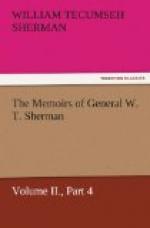Determined to bring the matter to an issue, I wrote the following letter:
Headquarters army of the united
states,
Washington, D. C., August 17, 1870.
General W. W. Belknap, Secretary of War.
General: I must urgently and respectfully invite your attention when at leisure to a matter of deep interest to future commanding generals of the army more than to myself, of the imperative necessity of fixing and clearly defining the limits of the powers and duties of the general of the army or of whomsoever may succeed to the place of commander-in-chief.
The case is well stated by General Grant in his letter of January 29, 1866, to the Secretary of War, Mr. Stanton, hereto appended, and though I find no official answer recorded, I remember that General Grant told me that the Secretary of War had promptly assured him in conversation that he fully approved of his views as expressed in this letter.
At that time the subject was much discussed, and soon after Congress enacted the bill reviving the grade of general, which bill was approved July 25, 1866, and provided that the general, when commissioned, may be authorized under the direction and during the pleasure of the President to command the armies of the United States; and a few days after, viz., July 28, 1866, was enacted the law which defined the military peace establishment. The enacting clause reads: “That the military peace establishment of the United States shall hereafter consist of five regiments of artillery, ten regiments of cavalry, forty-five regiments of infantry, the professors and Corps of Cadets of the United States Military Academy, and such other forces as shall be provided for by this act, to be known as the army of the United States.”
The act then recites in great detail all the parts of the army, making no distinction between the line and staff, but clearly makes each and every part an element of the whole.




